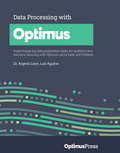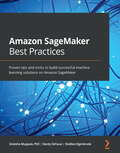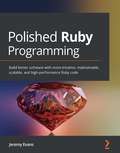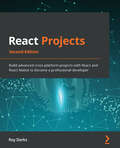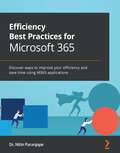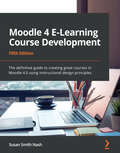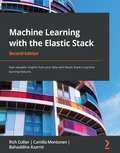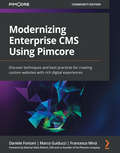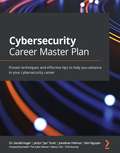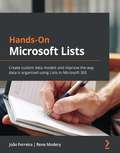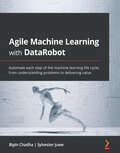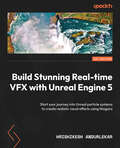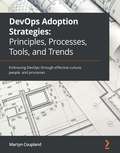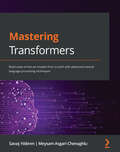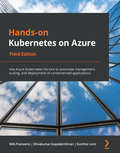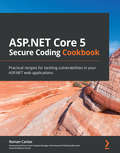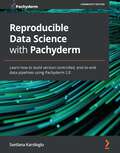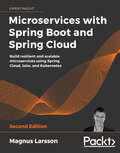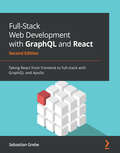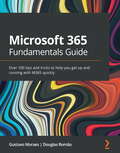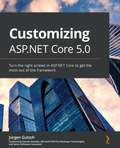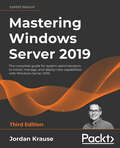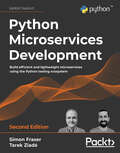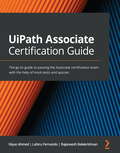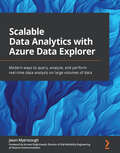- Table View
- List View
Data Processing with Optimus: Supercharge big data preparation tasks for analytics and machine learning with Optimus using Dask and PySpark
by Dr. Argenis Leon Luis AguirreWritten by the core Optimus team, this comprehensive guide will help you to understand how Optimus improves the whole data processing landscapeKey FeaturesLoad, merge, and save small and big data efficiently with OptimusLearn Optimus functions for data analytics, feature engineering, machine learning, cross-validation, and NLPDiscover how Optimus improves other data frame technologies and helps you speed up your data processing tasksBook DescriptionOptimus is a Python library that works as a unified API for data cleaning, processing, and merging data. It can be used for handling small and big data on your local laptop or on remote clusters using CPUs or GPUs.The book begins by covering the internals of Optimus and how it works in tandem with the existing technologies to serve your data processing needs. You'll then learn how to use Optimus for loading and saving data from text data formats such as CSV and JSON files, exploring binary files such as Excel, and for columnar data processing with Parquet, Avro, and OCR. Next, you'll get to grips with the profiler and its data types - a unique feature of Optimus Dataframe that assists with data quality. You'll see how to use the plots available in Optimus such as histogram, frequency charts, and scatter and box plots, and understand how Optimus lets you connect to libraries such as Plotly and Altair. You'll also delve into advanced applications such as feature engineering, machine learning, cross-validation, and natural language processing functions and explore the advancements in Optimus. Finally, you'll learn how to create data cleaning and transformation functions and add a hypothetical new data processing engine with Optimus.By the end of this book, you'll be able to improve your data science workflow with Optimus easily.What you will learnUse over 100 data processing functions over columns and other string-like valuesReshape and pivot data to get the output in the required formatFind out how to plot histograms, frequency charts, scatter plots, box plots, and moreConnect Optimus with popular Python visualization libraries such as Plotly and AltairApply string clustering techniques to normalize stringsDiscover functions to explore, fix, and remove poor quality dataUse advanced techniques to remove outliers from your dataAdd engines and custom functions to clean, process, and merge dataWho this book is forThis book is for Python developers who want to explore, transform, and prepare big data for machine learning, analytics, and reporting using Optimus, a unified API to work with Pandas, Dask, cuDF, Dask-cuDF, Vaex, and Spark. Although not necessary, beginner-level knowledge of Python will be helpful. Basic knowledge of the CLI is required to install Optimus and its requirements. For using GPU technologies, you'll need an NVIDIA graphics card compatible with NVIDIA's RAPIDS library, which is compatible with Windows 10 and Linux.
Amazon SageMaker Best Practices: Proven tips and tricks to build successful machine learning solutions on Amazon SageMaker
by Sireesha Muppala Randy DeFauw Shelbee EigenbrodeOvercome advanced challenges in building end-to-end ML solutions by leveraging the capabilities of Amazon SageMaker for developing and integrating ML models into productionKey FeaturesLearn best practices for all phases of building machine learning solutions - from data preparation to monitoring models in productionAutomate end-to-end machine learning workflows with Amazon SageMaker and related AWSDesign, architect, and operate machine learning workloads in the AWS CloudBook DescriptionAmazon SageMaker is a fully managed AWS service that provides the ability to build, train, deploy, and monitor machine learning models. The book begins with a high-level overview of Amazon SageMaker capabilities that map to the various phases of the machine learning process to help set the right foundation. You'll learn efficient tactics to address data science challenges such as processing data at scale, data preparation, connecting to big data pipelines, identifying data bias, running A/B tests, and model explainability using Amazon SageMaker. As you advance, you'll understand how you can tackle the challenge of training at scale, including how to use large data sets while saving costs, monitoring training resources to identify bottlenecks, speeding up long training jobs, and tracking multiple models trained for a common goal. Moving ahead, you'll find out how you can integrate Amazon SageMaker with other AWS to build reliable, cost-optimized, and automated machine learning applications. In addition to this, you'll build ML pipelines integrated with MLOps principles and apply best practices to build secure and performant solutions.By the end of the book, you'll confidently be able to apply Amazon SageMaker's wide range of capabilities to the full spectrum of machine learning workflows.What you will learnPerform data bias detection with AWS Data Wrangler and SageMaker ClarifySpeed up data processing with SageMaker Feature StoreOvercome labeling bias with SageMaker Ground TruthImprove training time with the monitoring and profiling capabilities of SageMaker DebuggerAddress the challenge of model deployment automation with CI/CD using the SageMaker model registryExplore SageMaker Neo for model optimizationImplement data and model quality monitoring with Amazon Model MonitorImprove training time and reduce costs with SageMaker data and model parallelismWho this book is forThis book is for expert data scientists responsible for building machine learning applications using Amazon SageMaker. Working knowledge of Amazon SageMaker, machine learning, deep learning, and experience using Jupyter Notebooks and Python is expected. Basic knowledge of AWS related to data, security, and monitoring will help you make the most of the book.
Polished Ruby Programming: Build better software with more intuitive, maintainable, scalable, and high-performance Ruby code
by Jeremy EvansBecome an accomplished Ruby programmer by understanding the design principles, best practices, and trade-offs involved in implementation approaches to keep your Ruby applications maintainable in the long termKey FeaturesUnderstand the design principles behind polished Ruby code and trade-offs between implementation approachesUse metaprogramming and DSLs to reduce the amount of code needed without decreasing maintainabilityLearn Ruby web application design principles and strategies for databases, security, and testingBook DescriptionMost successful Ruby applications become difficult to maintain over time as the codebase grows in size. Polished Ruby Programming provides you with recommendations and advice for designing Ruby programs that are easy to maintain in the long term. This book takes you through implementation approaches for many common programming situations, the trade-offs inherent in each approach, and why you may choose to use different approaches in different situations. You'll start by learning fundamental Ruby programming principles, such as correctly using core classes, class and method design, variable usage, error handling, and code formatting. Moving on, you'll learn higher-level programming principles, such as library design, use of metaprogramming and domain-specific languages, and refactoring. Finally, you'll learn principles specific to web application development, such as how to choose a database and web framework, and how to use advanced security features. By the end of this Ruby programming book, you'll have gained the skills you need to design robust, high-performance, scalable, and maintainable Ruby applications. While most code examples and principles discussed in the book apply to all Ruby versions, some examples and principles are specific to Ruby 3.0, the latest release at the time of publication.What you will learnUse Ruby's core classes and design custom classes effectivelyExplore the principles behind variable usage and method argument choiceImplement advanced error handling approaches such as exponential backoffDesign extensible libraries and plugin systems in RubyUse metaprogramming and DSLs to avoid code redundancyImplement different approaches to testing and understand their trade-offsDiscover design patterns, refactoring, and optimization with RubyExplore database design principles and advanced web app securityWho this book is forIf you already know how to program in Ruby and want to learn more about the principles and best practices behind writing maintainable, scalable, optimized, and well-structured Ruby code, then this Ruby book is for you. Intermediate to advanced-level working knowledge of the Ruby programming language is expected to get the most out of this book.
React Projects: Build advanced cross-platform projects with React and React Native to become a professional developer, 2nd Edition
by Roy Derks Kevin GoldsmithLearn how to develop real-world applications of varying complexity for the web, mobile, and VR devices using React, React Native, React 360, and moreKey FeaturesBuild React applications at scale using React patterns and best practicesExplore React features such as Hooks, the Context API, and the Suspense APIExtend React's integration with React Native for building cross-platform mobile apps and gamesBook DescriptionDeveloped by Facebook, React is a popular library for building impressive user interfaces. React extends its capabilities to mobile platforms using the React Native framework and integrates with popular web and mobile tools to build scalable applications.React Projects is your guide to learning React development by using modern development patterns and integrating React with powerful web tools, such as GraphQL, Expo, and React 360. You'll start building a real-world project right from the first chapter and get hands-on with developing scalable applications as you advance to building more complex projects. Throughout the book, you'll use the latest versions of React and React Native to explore features such as routing, Context, and Hooks on multiple platforms, which will help you build full-stack web and mobile applications efficiently. Finally, you'll get to grips with unit testing with Jest and end-to-end testing with Cypress to build test-driven apps.By the end of this React book, you'll have developed the skills necessary to start building scalable React apps across web and mobile platforms.What you will learnCreate a wide range of applications using various modern React tools and frameworksDiscover how React Hooks modernize state management for React appsDevelop web applications using styled and reusable React componentsBuild test-driven React applications using Jest, React Testing Library, and CypressUnderstand full-stack development using GraphQL, Apollo, and ReactPerform server-side rendering using React and Next.jsCreate animated games using React Native and ExpoDesign gestures and animations for a cross-platform game using React NativeWho this book is forThe book is for JavaScript developers who want to explore React tooling and frameworks for building cross-platform applications. Basic knowledge of web development, ECMAScript, and React will assist with understanding key concepts covered in this book.
Efficiency Best Practices for Microsoft 365: Discover ways to improve your efficiency and save time using M365 applications
by Dr. Nitin ParanjapeA practical guide to working with Microsoft 365 apps such as Office, Teams, Excel, and Power BI for automating tasks and managing projects effectivelyKey FeaturesLearn how to save time while using M365 apps from Microsoft productivity expert Dr. Nitin ParanjapeDiscover smarter ways to work with over 20 M365 apps to enhance your efficiencyUse Microsoft 365 tools to automate repetitive tasks without codingBook DescriptionEfficiency Best Practices for Microsoft 365 covers the entire range of over 25 desktop and mobile applications on the Microsoft 365 platform. This book will provide simple, immediately usable, and authoritative guidance to help you save at least 20 minutes every day, advance in your career, and achieve business growth.You'll start by covering components and tasks such as creating and storing files and then move on to data management and data analysis. As you progress through the chapters, you'll learn how to manage, monitor, and execute your tasks efficiently, focusing on creating a master task list, linking notes to meetings, and more. The book also guides you through handling projects involving many people and external contractors/agencies; you'll explore effective email communication, meeting management, and open collaboration across the organization. You'll also learn how to automate different repetitive tasks quickly and easily, even if you're not a programmer, transforming the way you import, clean, and analyze data.By the end of this Microsoft 365 book, you'll have gained the skills you need to improve efficiency with the help of expert tips and techniques for using M365 apps.What you will learnUnderstand how different MS 365 tools, such as Office desktop, Teams, Power BI, Lists, and OneDrive, can increase work efficiencyIdentify time-consuming processes and understand how to work through them more efficientlyCreate professional documents quickly with minimal effortWork across multiple teams, meetings, and projects without email overloadAutomate mundane, repetitive, and time-consuming manual workManage work, delegation, execution, and project managementWho this book is forIf you use Microsoft 365, including MS Office 365, on a regular basis and want to learn about the features that can help improve your efficiency, this book is for you. You do not require any specialized knowledge to get started.
Moodle 4 E-Learning Course Development: The definitive guide to creating great courses in Moodle 4.0 using instructional design principles, 5th Edition
by Susan Smith Nash William RiceLeverage Moodle 4.0's improved UX features and new tools to create effective courses in today's competitive world of online learning, including blended live and on-demand deliveryKey FeaturesDesign courses that are easy to navigate and have easy-to-use productivity toolsEffectively incorporate text, audio, video, and graphics that are ADA compliant and meet the needs of all kinds of learnersBuild the best assessment tools for your learning objectivesBook DescriptionMoodle 4.0 maintains its flexible, powerful, and easy-to-use platform while adding impressive new features to enhance the user experience for student success.This updated edition addresses the opportunities that come with a major update in Moodle 4.0. You'll learn how to determine the best way to use the Moodle platform's new features and configure your courses to align with your overall goals, vision, and even accreditation review needs. You'll discover how to plan an effective course with the best mix of resources and engaging assessments that really show what the learner has accomplished, and also keep them engaged and interested. This book will show you how to ensure that your students enjoy their collaborations and truly learn from each other. You'll get a handle on generating reports and monitoring exactly how the courses are going and what to do to get them back on track. While doing this, you can use Moodle 4.0's new navigation features to help keep students from getting “lost.” Finally, you'll be able to incorporate functionality boosters and accommodate the changing needs and goals of our evolving world.By the end of this Moodle book, you'll be able to build and deploy your educational program to align with learning objectives and include an entire array of course content.What you will learnBuild courses that emphasize the achievement of learning objectivesWrite a variety of effective quizzes that can be taken online and offlineMake the most of the navigation and user experience improvements made to Moodle 4.0Build courses that reflect current interactive teaching practices, including hybrid learning with web conferencingOptimize all kinds of content – text, graphics, audio, video, and recorded webcastsEncourage student engagement and collaborationIncorporate functionality builders for more responsive and adaptive learningWho this book is forThis book is for novice as well as experienced course developers who want to incorporate Moodle 4.0's powerful features and make life easier for students, instructors, and administrators. The powerful and flexible Moodle platform will also help with accreditation and for deploying across devices to people in diverse situations.
Machine Learning with the Elastic Stack: Gain valuable insights from your data with Elastic Stack's machine learning features, 2nd Edition
by Rich Collier Camilla Montonen Bahaaldine AzarmiDiscover expert techniques for combining machine learning with the analytic capabilities of Elastic Stack and uncover actionable insights from your dataKey FeaturesIntegrate machine learning with distributed search and analyticsPreprocess and analyze large volumes of search data effortlesslyOperationalize machine learning in a scalable, production-worthy wayBook DescriptionElastic Stack, previously known as the ELK stack, is a log analysis solution that helps users ingest, process, and analyze search data effectively. With the addition of machine learning, a key commercial feature, the Elastic Stack makes this process even more efficient. This updated second edition of Machine Learning with the Elastic Stack provides a comprehensive overview of Elastic Stack's machine learning features for both time series data analysis as well as for classification, regression, and outlier detection. The book starts by explaining machine learning concepts in an intuitive way. You'll then perform time series analysis on different types of data, such as log files, network flows, application metrics, and financial data. As you progress through the chapters, you'll deploy machine learning within Elastic Stack for logging, security, and metrics. Finally, you'll discover how data frame analysis opens up a whole new set of use cases that machine learning can help you with. By the end of this Elastic Stack book, you'll have hands-on machine learning and Elastic Stack experience, along with the knowledge you need to incorporate machine learning in your distributed search and data analysis platform.What you will learnFind out how to enable the ML commercial feature in the Elastic StackUnderstand how Elastic machine learning is used to detect different types of anomalies and make predictionsApply effective anomaly detection to IT operations, security analytics, and other use casesUtilize the results of Elastic ML in custom views, dashboards, and proactive alertingTrain and deploy supervised machine learning models for real-time inferenceDiscover various tips and tricks to get the most out of Elastic machine learningWho this book is forIf you're a data professional looking to gain insights into Elasticsearch data without having to rely on a machine learning specialist or custom development, then this Elastic Stack machine learning book is for you. You'll also find this book useful if you want to integrate machine learning with your observability, security, and analytics applications. Working knowledge of the Elastic Stack is needed to get the most out of this book.
Modernizing Enterprise CMS Using Pimcore: Discover techniques and best practices for creating custom websites with rich digital experiences
by Daniele Fontani Marco Guiducci Francesco Mina Dietmar Dietz RietschA practical guide to developing, administering, and scaling content management solutions in your organization for supporting digital transformation using PimcoreKey FeaturesKick-start your CMS career by preparing for Pimcore developer certificationsCreate custom websites with a rich digital experience for your business users with the help of step-by-step examplesGet to grips with Pimcore's enterprise features for product management and data managementBook DescriptionUsed by over eighty thousand companies worldwide, Pimcore is the leading open source enterprise-level content management system (CMS) solution. It is an impressive alternative to conventional CMSes and is ideal for creating e-commerce and complex enterprise websites. This book helps developers working with standard CMSes such as WordPress and Drupal to use their knowledge of CMSes to learn Pimcore CMS in a practical way. You'll start by learning what Pimcore is and explore its various services such as PIM, MDM, and DAM. The book then shows you various techniques for developing custom websites in Pimcore based on the scale of your organization. You'll learn how to use Pimcore to improve the digital transformation of a company by implementing enterprise Pimcore features. As you advance, you'll discover Pimcore's capabilities and features that make it a faster and more secure alternative to traditional CMSes. As well as demonstrating practical use cases, Modernizing Enterprise CMS Using Pimcore can help you understand the benefits of using Pimcore as a CMS solution, sharing best practices and proven techniques for designing professional Pimcore sites. By the end of this book, you'll be a trained Pimcore developer, able to create complex websites, and be well-versed in Pimcore's enterprise features such as MDM, PIM, and DAM.What you will learnCreate, edit, and manage Pimcore documents for your web pagesManage web assets in Pimcore using the digital asset management (DAM) featureDiscover how to create layouts, templates, and custom widgets for your web pagesAdminister third-party add-ons for your Pimcore site using the admin UIDiscover practices to use Pimcore as a product information management (PIM) systemExplore Pimcore's master data management (MDM) for enterprise CMS developmentBuild reusable website components and save time using effective tips and tricksWho this book is forThis book is for web developers and CMS professionals looking for an alternative to WordPress and traditional CMS. Enterprise application developers looking for enterprise solutions for digital transformation will find this book useful. Beginner-level knowledge of PHP, HTML, and CSS is needed to understand the code examples used in the book.
Cybersecurity Career Master Plan: Proven techniques and effective tips to help you advance in your cybersecurity career
by Dr. Gerald Auger Jaclyn “Jax” Scott Jonathan Helmus Kim Nguyen Heath "The AdamsGet started with cybersecurity and progress with the help of expert tips to get certified, find a job, and moreKey FeaturesLearn how to follow your desired career path that results in a well-paid, rewarding job in cybersecurityExplore expert tips relating to career paths and certification optionsAccess informative content from a panel of experienced cybersecurity expertsBook DescriptionCybersecurity is an emerging career trend and will continue to become increasingly important. Despite the lucrative pay and significant career growth opportunities, many people are unsure of how to get started.This book is designed by leading industry experts to help you enter the world of cybersecurity with confidence, covering everything from gaining the right certification to tips and tools for finding your first job. The book starts by helping you gain a foundational understanding of cybersecurity, covering cyber law, cyber policy, and frameworks. Next, you'll focus on how to choose the career field best suited to you from options such as security operations, penetration testing, and risk analysis. The book also guides you through the different certification options as well as the pros and cons of a formal college education versus formal certificate courses. Later, you'll discover the importance of defining and understanding your brand. Finally, you'll get up to speed with different career paths and learning opportunities.By the end of this cyber book, you will have gained the knowledge you need to clearly define your career path and develop goals relating to career progression.What you will learnGain an understanding of cybersecurity essentials, including the different frameworks and laws, and specialtiesFind out how to land your first job in the cybersecurity industryUnderstand the difference between college education and certificate coursesBuild goals and timelines to encourage a work/life balance while delivering value in your jobUnderstand the different types of cybersecurity jobs available and what it means to be entry-levelBuild affordable, practical labs to develop your technical skillsDiscover how to set goals and maintain momentum after landing your first cybersecurity jobWho this book is forThis book is for college graduates, military veterans transitioning from active service, individuals looking to make a mid-career switch, and aspiring IT professionals. Anyone who considers cybersecurity as a potential career field but feels intimidated, overwhelmed, or unsure of where to get started will also find this book useful.
Hands-On Microsoft Lists: Create custom data models and improve the way data is organized using Lists in Microsoft 365
by Joao Ferreira Rene ModeryPrepare to be a Microsoft Lists advocate and transform the way data is harnessed in your organizationKey FeaturesGet to grips with Microsoft Lists and organize your data efficientlyDiscover best practices and real-world scenarios to track information, events, and issues in your organizationTake control of your data by creating custom data models using Microsoft ListsBook DescriptionMicrosoft Lists is an extremely flexible and powerful platform for creating custom data models. Hands-On Microsoft Lists is an easy-to-read guide for those who want to get started with Lists, as well as those who are already familiar with the basic concepts and want to create custom and flexible Lists that are easily available through a web interface. This comprehensive introduction to Lists will show you how to get up to speed in no time with the help of practical guidance and examples. Complete with hands-on tutorials and projects, you'll understand how to use and implement Microsoft Lists effectively. You'll start by covering all the basic concepts that will help you to build your Microsoft Lists and get the most out of the platform. As you progress, you'll explore how to customize Microsoft Lists layouts and forms. Later chapters will guide you through integrating Microsoft Lists with the Power Platform. Throughout the book, you'll work with practical scenarios that you can use daily to improve the collaboration in your organization. By the end of this Microsoft book, you'll have learned how to create custom data models to improve the way your data is put together, managed, and consumed in your workplace.What you will learnUse the Lists platform effectively in the modern workplaceGet to grips with data privacyDiscover how to customize Microsoft Lists data and formsAutomate processes using Microsoft ListsExtend the default features of Microsoft Lists using the SharePoint frameworkCreate custom list templates using PnP PowerShellExtend Microsoft Lists using Power PlatformWho this book is forThis book is for business professionals and end users working with Microsoft 365 tools such as Microsoft SharePoint and Microsoft Teams who are looking to improve the way their data is structured, managed, and consumed inside an organization. Basic knowledge of SharePoint and Excel is assumed.
Agile Machine Learning with DataRobot: Automate each step of the machine learning life cycle, from understanding problems to delivering value
by Bipin Chadha Sylvester JuweLeverage DataRobot's enterprise AI platform and automated decision intelligence to extract business value from dataKey FeaturesGet well-versed with DataRobot features using real-world examplesUse this all-in-one platform to build, monitor, and deploy ML models for handling the entire production life cycleMake use of advanced DataRobot capabilities to programmatically build and deploy a large number of ML modelsBook DescriptionDataRobot enables data science teams to become more efficient and productive. This book helps you to address machine learning (ML) challenges with DataRobot's enterprise platform, enabling you to extract business value from data and rapidly create commercial impact for your organization.You'll begin by learning how to use DataRobot's features to perform data prep and cleansing tasks automatically. The book then covers best practices for building and deploying ML models, along with challenges faced while scaling them to handle complex business problems. Moving on, you'll perform exploratory data analysis (EDA) tasks to prepare your data to build ML models and ways to interpret results. You'll also discover how to analyze the model's predictions and turn them into actionable insights for business users. Next, you'll create model documentation for internal as well as compliance purposes and learn how the model gets deployed as an API. In addition, you'll find out how to operationalize and monitor the model's performance. Finally, you'll work with examples on time series forecasting, NLP, image processing, MLOps, and more using advanced DataRobot capabilities.By the end of this book, you'll have learned to use DataRobot's AutoML and MLOps features to scale ML model building by avoiding repetitive tasks and common errors.What you will learnUnderstand and solve business problems using DataRobotUse DataRobot to prepare your data and perform various data analysis tasks to start building modelsDevelop robust ML models and assess their results correctly before deploymentExplore various DataRobot functions and outputs to help you understand the models and select the one that best solves the business problemAnalyze a model's predictions and turn them into actionable insights for business usersUnderstand how DataRobot helps in governing, deploying, and maintaining ML modelsWho this book is forThis book is for data scientists, data analysts, and data enthusiasts looking for a practical guide to building and deploying robust machine learning models using DataRobot. Experienced data scientists will also find this book helpful for rapidly exploring, building, and deploying a broader range of models. The book assumes a basic understanding of machine learning.
Build Stunning Real-time VFX with Unreal Engine 5: Start your journey into Unreal particle systems to create realistic visual effects using Niagara
by Hrishikesh AndurlekarCreate professional real-time particle systems and particle asset creation workflows for games with the power of Niagara and Unreal Engine 5Key FeaturesExplore how Niagara can make your games pop by creating stunning particle systems in Unreal Engine 5Level up your VFX skills and enhance your employability in a competitive marketBuild various particle system projects to reinforce your learning and put your new knowledge into practiceBook DescriptionWhile no game would be complete without visual effects, the ever-evolving VFX industry churns out stellar digital environments that can make your games stand out from the crowd. Build Stunning Real-time VFX with Unreal Engine 5 is here to help you boost your creativity using Niagara to make jaw-dropping particle systems backed by the power of Unreal Engine 5—without a line of code. This handy guide for VFX artists takes you through the principles and concepts of designing particle systems and design workflows, along with the architecture of Niagara, Unreal Engine 5's VFX system. Throughout the book, you'll build a series of mini projects that will put your particle system knowledge to the test. As you advance, you'll cover topics such as creating your own custom modules, debugging workflows, and controlling particles with blueprints, and conclude by working on two projects that will bring everything together into a neat package. By the end of this VFX book, you'll have a deeper understanding of particle systems, improving your skills, portfolio, and the chances of being employed by studios using Unreal Engine 5.What you will learnBrush up your vector mathematics skillsAccess and create namespaces in NiagaraAdd a Niagara system to a Blueprint actorCreate a particle system with dynamic inputsPublish a custom module for your team members to useCreate Niagara Scratch modulesEnable your particle emitters to communicate using event handlersControl Niagara systems using Blueprint public variablesWho this book is forThis book is for visual effects artists transitioning to real-time virtual production workflow as well as beginners looking to learn Niagara for games and other real-time applications. Game programmers, 3D generalists, and game designers interested in adding VFX for their game and metaverse projects will also find this book useful. A basic understanding of Unreal Engine 5, blueprints, as well as layout, materials, and lighting in Unreal Engine is expected.
DevOps Adoption Strategies: Embracing DevOps through effective culture, people, and processes
by Martyn CouplandGain in-depth insight into DevOps relative to your field of expertise and implement effective DevOps culture and processes within your organizationKey FeaturesPacked with step-by-step explanations and practical examples to help you get started with DevOpsDevelop the skills and knowledge you need to tackle the deployment of DevOps toolsDiscover technology trends such as FinOps and DevSecOps to get more value from DevOpsBook DescriptionDevOps is a set of best practices enabling operations and development teams to work together to produce higher-quality work and, among other things, quicker releases. This book helps you to understand the fundamentals needed to get started with DevOps, and prepares you to start deploying technical tools confidently. You will start by learning the key steps for implementing successful DevOps transformations. The book will help you to understand how aspects of culture, people, and process are all connected, and that without any one of these elements DevOps is unlikely to be successful. As you make progress, you will discover how to measure and quantify the success of DevOps in your organization, along with exploring the pros and cons of the main tooling involved in DevOps. In the concluding chapters, you will learn about the latest trends in DevOps and find out how the tooling changes when you work with these specialties. By the end of this DevOps book, you will have gained a clear understanding of the connection between culture, people, and processes within DevOps, and learned why all three are critically important.What you will learnUnderstand the importance of culture in DevOpsBuild, foster, and develop a successful DevOps cultureDiscover how to implement a successful DevOps frameworkMeasure and define the success of DevOps transformationGet to grips with techniques for continuous feedback and iterate process changesDiscover the tooling used in different stages of the DevOps life cycleWho this book is forThis book is for IT professionals such as support engineers and systems engineers and developers looking to learn DevOps and for those going through DevOps transformation. General knowledge of IT and business processes will be helpful. You'll also find this book useful if you are in a business or service role within technology such as service delivery management. Basic familiarity with DevOps and transformational methods such as value streams and process are needed to get the most out of this book.
Mastering Transformers: Build state-of-the-art models from scratch with advanced natural language processing techniques
by Savas Yildirim Meysam Asgari-ChenaghluTake a problem-solving approach to learning all about transformers and get up and running in no time by implementing methodologies that will build the future of NLPKey FeaturesExplore quick prototyping with up-to-date Python libraries to create effective solutions to industrial problemsSolve advanced NLP problems such as named-entity recognition, information extraction, language generation, and conversational AIMonitor your model's performance with the help of BertViz, exBERT, and TensorBoardBook DescriptionTransformer-based language models have dominated natural language processing (NLP) studies and have now become a new paradigm. With this book, you'll learn how to build various transformer-based NLP applications using the Python Transformers library. The book gives you an introduction to Transformers by showing you how to write your first hello-world program. You'll then learn how a tokenizer works and how to train your own tokenizer. As you advance, you'll explore the architecture of autoencoding models, such as BERT, and autoregressive models, such as GPT. You'll see how to train and fine-tune models for a variety of natural language understanding (NLU) and natural language generation (NLG) problems, including text classification, token classification, and text representation. This book also helps you to learn efficient models for challenging problems, such as long-context NLP tasks with limited computational capacity. You'll also work with multilingual and cross-lingual problems, optimize models by monitoring their performance, and discover how to deconstruct these models for interpretability and explainability. Finally, you'll be able to deploy your transformer models in a production environment. By the end of this NLP book, you'll have learned how to use Transformers to solve advanced NLP problems using advanced models.What you will learnExplore state-of-the-art NLP solutions with the Transformers libraryTrain a language model in any language with any transformer architectureFine-tune a pre-trained language model to perform several downstream tasksSelect the right framework for the training, evaluation, and production of an end-to-end solutionGet hands-on experience in using TensorBoard and Weights & BiasesVisualize the internal representation of transformer models for interpretabilityWho this book is forThis book is for deep learning researchers, hands-on NLP practitioners, as well as ML/NLP educators and students who want to start their journey with Transformers. Beginner-level machine learning knowledge and a good command of Python will help you get the best out of this book.
Hands-on Kubernetes on Azure: Use Azure Kubernetes Service to automate management, scaling, and deployment of containerized applications, 3rd Edition
by Nills Franssens Shivakumar Gopalakrishnan Gunther LenzUnderstand the fundamentals of Kubernetes deployment on Azure with a learn-by-doing approachKey FeaturesGet to grips with the fundamentals of containers and KubernetesDeploy containerized applications using the Kubernetes platformLearn how you can scale your workloads and secure your application running in Azure Kubernetes ServiceBook DescriptionContainers and Kubernetes containers facilitate cloud deployments and application development by enabling efficient versioning with improved security and portability. With updated chapters on role-based access control, pod identity, storing secrets, and network security in AKS, this third edition begins by introducing you to containers, Kubernetes, and Azure Kubernetes Service (AKS), and guides you through deploying an AKS cluster in different ways. You will then delve into the specifics of Kubernetes by deploying a sample guestbook application on AKS and installing complex Kubernetes apps using Helm. With the help of real-world examples, you'll also get to grips with scaling your applications and clusters. As you advance, you'll learn how to overcome common challenges in AKS and secure your applications with HTTPS. You will also learn how to secure your clusters and applications in a dedicated section on security. In the final section, you'll learn about advanced integrations, which give you the ability to create Azure databases and run serverless functions on AKS as well as the ability to integrate AKS with a continuous integration and continuous delivery (CI/CD) pipeline using GitHub Actions. By the end of this Kubernetes book, you will be proficient in deploying containerized workloads on Microsoft Azure with minimal management overhead.What you will learnPlan, configure, and run containerized applications in production.Use Docker to build applications in containers and deploy them on Kubernetes.Monitor the AKS cluster and the application.Monitor your infrastructure and applications in Kubernetes using Azure Monitor.Secure your cluster and applications using Azure-native security tools.Connect an app to the Azure database.Store your container images securely with Azure Container Registry.Install complex Kubernetes applications using Helm.Integrate Kubernetes with multiple Azure PaaS services, such as databases, Azure Security Center, and Functions.Use GitHub Actions to perform continuous integration and continuous delivery to your cluster.Who this book is forIf you are an aspiring DevOps professional, system administrator, developer, or site reliability engineer interested in learning how to get the most out of containers and Kubernetes, then this book is for you.
ASP.NET Core 5 Secure Coding Cookbook: Practical recipes for tackling vulnerabilities in your ASP.NET web applications
by Roman CanlasLearn how to secure your ASP.NET Core web app through robust and secure codeKey FeaturesDiscover the different types of security weaknesses in ASP.NET Core web applications and learn how to fix themUnderstand what code makes an ASP.NET Core web app unsafeBuild your secure coding knowledge by following straightforward recipesBook DescriptionASP.NET Core developers are often presented with security test results showing the vulnerabilities found in their web apps. While the report may provide some high-level fix suggestions, it does not specify the exact steps that you need to take to resolve or fix weaknesses discovered by these tests. In ASP.NET Secure Coding Cookbook, you'll start by learning the fundamental concepts of secure coding and then gradually progress to identifying common web app vulnerabilities in code. As you progress, you'll cover recipes for fixing security misconfigurations in ASP.NET Core web apps. The book further demonstrates how you can resolve different types of Cross-Site Scripting. A dedicated section also takes you through fixing miscellaneous vulnerabilities that are no longer in the OWASP Top 10 list. This book features a recipe-style format, with each recipe containing sample unsecure code that presents the problem and corresponding solutions to eliminate the security bug. You'll be able to follow along with each step of the exercise and use the accompanying sample ASP.NET Core solution to practice writing secure code. By the end of this book, you'll be able to identify unsecure code causing different security flaws in ASP.NET Core web apps and you'll have gained hands-on experience in removing vulnerabilities and security defects from your code.What you will learnUnderstand techniques for squashing an ASP.NET Core web app security bugDiscover different types of injection attacks and understand how you can prevent this vulnerability from being exploitedFix security issues in code relating to broken authentication and authorizationEliminate the risks of sensitive data exposure by getting up to speed with numerous protection techniquesPrevent security misconfiguration by enabling ASP.NET Core web application security featuresExplore other ASP.NET web application vulnerabilities and secure coding best practicesWho this book is forThis ASP.NET Core book is for intermediate-level ASP.NET Core web developers and software engineers who use the framework to develop web applications and are looking to focus on their security using coding best practices. The book is also for application security engineers, analysts, and specialists who want to know more about securing ASP.NET Core using code and understand how to resolve issues identified by the security tests they perform daily.
Reproducible Data Science with Pachyderm: Learn how to build version-controlled, end-to-end data pipelines using Pachyderm 2.0
by Svetlana KarsliogluCreate scalable and reliable data pipelines easily with PachydermKey FeaturesLearn how to build an enterprise-level reproducible data science platform with PachydermDeploy Pachyderm on cloud platforms such as AWS EKS, Google Kubernetes Engine, and Microsoft Azure Kubernetes ServiceIntegrate Pachyderm with other data science tools, such as Pachyderm NotebooksBook DescriptionPachyderm is an open source project that enables data scientists to run reproducible data pipelines and scale them to an enterprise level. This book will teach you how to implement Pachyderm to create collaborative data science workflows and reproduce your ML experiments at scale.You'll begin your journey by exploring the importance of data reproducibility and comparing different data science platforms. Next, you'll explore how Pachyderm fits into the picture and its significance, followed by learning how to install Pachyderm locally on your computer or a cloud platform of your choice. You'll then discover the architectural components and Pachyderm's main pipeline principles and concepts. The book demonstrates how to use Pachyderm components to create your first data pipeline and advances to cover common operations involving data, such as uploading data to and from Pachyderm to create more complex pipelines. Based on what you've learned, you'll develop an end-to-end ML workflow, before trying out the hyperparameter tuning technique and the different supported Pachyderm language clients. Finally, you'll learn how to use a SaaS version of Pachyderm with Pachyderm Notebooks.By the end of this book, you will learn all aspects of running your data pipelines in Pachyderm and manage them on a day-to-day basis.What you will learnUnderstand the importance of reproducible data science for enterpriseExplore the basics of Pachyderm, such as commits and branchesUpload data to and from PachydermImplement common pipeline operations in PachydermCreate a real-life example of hyperparameter tuning in PachydermCombine Pachyderm with Pachyderm language clients in Python and GoWho this book is forThis book is for new as well as experienced data scientists and machine learning engineers who want to build scalable infrastructures for their data science projects. Basic knowledge of Python programming and Kubernetes will be beneficial. Familiarity with Golang will be helpful.
Microservices with Spring Boot and Spring Cloud: Build resilient and scalable microservices using Spring Cloud, Istio, and Kubernetes, 2nd Edition
by Magnus LarssonA step-by-step guide to creating and deploying production-quality microservices-based applicationsKey FeaturesBuild cloud-native production-ready microservices with this comprehensively updated guideUnderstand the challenges of building large-scale microservice architecturesLearn how to get the best out of Spring Cloud, Kubernetes, and Istio in combinationBook DescriptionWith this book, you'll learn how to efficiently build and deploy microservices. This new edition has been updated for the most recent versions of Spring, Java, Kubernetes, and Istio, demonstrating faster and simpler handling of Spring Boot, local Kubernetes clusters, and Istio installation. The expanded scope includes native compilation of Spring-based microservices, support for Mac and Windows with WSL2, and an introduction to Helm 3 for packaging and deployment. A revamped security chapter now follows the OAuth 2.1 specification and makes use of the newly launched Spring Authorization Server from the Spring team. Starting with a set of simple cooperating microservices, you'll add persistence and resilience, make your microservices reactive, and document their APIs using OpenAPI. You'll understand how fundamental design patterns are applied to add important functionality, such as service discovery with Netflix Eureka and edge servers with Spring Cloud Gateway. You'll learn how to deploy your microservices using Kubernetes and adopt Istio. You'll explore centralized log management using the Elasticsearch, Fluentd, and Kibana (EFK) stack and monitor microservices using Prometheus and Grafana. By the end of this book, you'll be confident in building microservices that are scalable and robust using Spring Boot and Spring Cloud.What you will learnBuild reactive microservices using Spring BootDevelop resilient and scalable microservices using Spring CloudUse OAuth 2.1/OIDC and Spring Security to protect public APIsImplement Docker to bridge the gap between development, testing, and productionDeploy and manage microservices with KubernetesApply Istio for improved security, observability, and traffic managementWrite and run automated microservice tests with JUnit, testcontainers, Gradle, and bashWho this book is forThis book is intended for Java and Spring developers and architects who want to learn how to build microservice landscapes from the ground up and deploy them either on-premises or in the cloud, using Kubernetes as a container orchestrator and Istio as a service mesh.No familiarity with microservices architecture is required to get started with this book.
Full-Stack Web Development with GraphQL and React: Taking React from frontend to full-stack with GraphQL and Apollo, 2nd Edition
by Sebastian GrebeUnleash the power of GraphQL, React 17, Node, and Express to build a scalable and production-ready application from scratch to be deployed on AWSKey FeaturesBuild full-stack applications with modern APIs using GraphQL and React HooksIntegrate Apollo into React and build frontend components using GraphQLImplement a self-updating notification pop-up with a unique GraphQL feature called SubscriptionsBook DescriptionReact and GraphQL, when combined, provide you with a very dynamic, efficient, and stable tech stack to build web-based applications. GraphQL is a modern solution for querying an API that represents an alternative to REST and is the next evolution in web development.This book guides you in creating a full-stack web application from scratch using modern web technologies such as Apollo, Express.js, Node.js, and React. First, you'll start by configuring and setting up your development environment. Next, the book demonstrates how to solve complex problems with GraphQL, such as abstracting multi-table database architectures and handling image uploads using Sequelize. You'll then build a complete Graphbook from scratch. While doing so, you'll cover the tricky parts of connecting React to the backend, and maintaining and synchronizing state. In addition to this, you'll also learn how to write Reusable React components and use React Hooks. Later chapters will guide you through querying data and authenticating users in order to enable user privacy. Finally, you'll explore how to deploy your application on AWS and ensure continuous deployment using Docker and CircleCI.By the end of this web development book, you'll have learned how to build and deploy scalable full-stack applications with ease using React and GraphQL.What you will learnBuild a GraphQL API by implementing models and schemas with Apollo and SequelizeSet up an Apollo Client and build frontend components using ReactWrite Reusable React components and use React HooksAuthenticate and query user data using GraphQLUse Mocha to write test cases for your full-stack applicationDeploy your application to AWS using Docker and CircleCIWho this book is forThis React GraphQL book is for web developers familiar with React and GraphQL who want to enhance their skills and build full-stack applications using industry standards like React, Apollo, Node.js, and SQL at scale while learning to solve complex problems with GraphQL.
Microsoft 365 Fundamentals Guide: Over 100 tips and tricks to help you get up and running with M365 quickly
by Gustavo Moraes Douglas RomaoBecome a Microsoft 365 superuser and overcome challenges using the wide range of features offered by Microsoft 365 apps including SharePoint, Teams, Power Automate, Planner, and To-DoKey FeaturesEnhance your productivity with this consolidated guide to using all the tools available in Microsoft 365Improve your collaboration and maximize efficiency using various M365 featuresIntegrate project, task, and people management within one ecosystemBook DescriptionWith its extensive set of tools and features for improving productivity and collaboration, Microsoft 365 is being widely adopted by organizations worldwide. This book will help not only developers but also business people and those working with information to discover tips and tricks for making the most of the apps in the Microsoft 365 suite.The Microsoft 365 Fundamentals Guide is a compendium of best practices and tips to leverage M365 apps for effective collaboration and productivity. You'll find all that you need to work efficiently with the apps in the Microsoft 365 family in this complete, quick-start guide that takes you through the Microsoft 365 apps that you can use for your everyday activities. You'll learn how to boost your personal productivity with Microsoft Delve, MyAnalytics, Outlook, and OneNote. To enhance your communication and collaboration with teams, this book shows you how to make the best use of Microsoft OneDrive, Whiteboard, SharePoint, and Microsoft Teams. You'll also be able to be on top of your tasks and your team's activities, automating routines, forms, and apps with Microsoft Planner, To-Do, Power Automate, Power Apps, and Microsoft Forms.By the end of this book, you'll have understood the purpose of each Microsoft 365 app, when and how to use it, and learned tips and tricks to achieve more with M365.What you will learnUnderstand your Microsoft 365 apps betterApply best practices to boost your personal productivityFind out how to improve communications and collaboration within your teamsDiscover how to manage tasks and automate processesGet to know the features of M365 and how to implement them in your daily activitiesBuild an integrated system for clear and effective communicationWho this book is forWhether you're new to Microsoft 365 or an existing user looking to explore its wide range of features, you'll find this book helpful. Get started using this introductory guide or use it as a handy reference to explore the features of Microsoft 365. All you need is a basic understanding of computers.
Customizing ASP.NET Core 5.0: Turn the right screws in ASP.NET Core to get the most out of the framework
by Jurgen Gutsch Damien BowdenA guide to discovering the hidden behaviors of ASP.NET Core that can be customized to optimize your .NET 5 applicationsKey FeaturesCustomize the default behavior of ASP.NET Core to get the most out of the frameworkEnhance the app configuration, change the default dependency injection, and build your own tag helpersDiscover best practices for configuring ASP.NET Core, from user interface design to hosting it on platformsBook DescriptionASP.NET Core is the most powerful Microsoft web framework. Although it's full of rich features, sometimes the default configurations can be a bottleneck and need to be customized to suit the nature and scale of your app. If you're an intermediate-level .NET developer who wants to extend .NET Core to multiple use cases, it's important to customize these features so that the framework works for you effectively. Customizing ASP.NET Core 5.0 covers core features that can be customized for developing optimized apps. The customization techniques are also updated to work with the latest .NET 5 framework. You'll learn essential concepts relating to optimizing the framework such as configuration, dependency injection, routing, action filters, and more. As you progress, you'll be able to create custom solutions that meet the needs of your use case with ASP.NET Core. Later chapters will cover expert techniques and best practices for using the framework for your app development needs, from UI design to hosting. Finally, you'll focus on the new endpoint routing in ASP.NET Core to build custom endpoints and add third-party endpoints to your web apps for processing requests faster. By the end of this application development book, you'll have the skills you need to be able to customize ASP.NET Core to develop robust optimized apps.What you will learnExplore various application configurations and providers in ASP.NET Core 5Understand dependency injection in .NET and learn how to add third-party DI containersDiscover the concept of middleware and write your own middleware for ASP.NET Core appsCreate various API output formats in your API-driven projectsGet familiar with different hosting models for your ASP.NET Core appDevelop custom routing endpoints and add third-party endpointsConfigure WebHostBuilder effectively for your web applicationsWho this book is forThis .NET 5 book is for .NET developers who need to change the default behaviors of the framework to help improve the performance of their applications. Intermediate-level knowledge of ASP.NET Core and C# is required before getting started with the book.
Mastering Windows Server 2019: The complete guide for system administrators to install, manage, and deploy new capabilities with Windows Server 2019, 3rd Edition
by Jordan KrauseEnhance and secure your datacenter with Microsoft Windows Server 2019Key FeaturesUpdated with four new chapters on Active Directory, DNS and DHCP, group policy, and troubleshootingDesign and implement Microsoft Server 2019 in an enterprise environmentLearn how to use Windows Server to create secure and efficient networksBook DescriptionWindows Server 2019 has a lot to offer, with a variety of roles, features, toolsets, and server management interfaces that allow interaction with your servers from virtually anywhere in the world. This updated edition comes with four new chapters to provide you with the in-depth knowledge needed to implement and use this operating system in any environment. Centralized management, monitoring, and configuration of servers are key to an efficient IT department. This book delves into multiple methods for quickly managing all your servers from a �single pane of glass' — the ability to monitor different servers across a network using Server Manager, Windows PowerShell, and even Windows Admin Center — from anywhere. Despite the book being more focused on Windows Server 2019 LTSC, you will still explore containers and Nano Server, which are more related to the SAC of server releases. This additional coverage will give you insights into all aspects of using Windows Server 2019 in your environment. This book covers a range of remote access technologies available in this operating system, teaches management of PKI and certificates, and empowers you to virtualize your datacenter with Hyper-V. You will also discover the tools and software included with Windows Server 2019 that assist in the inevitable troubleshooting of problems that crop up.What you will learnWork with Server Core and Windows Admin CenterSecure your network and data with modern technologies in Windows Server 2019Understand containers and understand when to use Nano ServerDiscover new ways to integrate your datacenter with Microsoft AzureReinforce and secure your Windows ServerVirtualize your datacenter with Hyper-VExplore Server Manager, PowerShell, and Windows Admin CenterCentralize your information and services using Active Directory and Group PolicyWho this book is forIf you are a system administrator or an IT professional designing and deploying Windows Server 2019, this book is for you. Prior experience with Windows Server operating systems and familiarity with networking concepts is required.
Python Microservices Development: Build efficient and lightweight microservices using the Python tooling ecosystem, 2nd Edition
by Simon Fraser Tarek ZiadeUse Python microservices to craft applications that are built as small standard units using proven best practices and avoiding common errorsKey FeaturesBecome well versed with the fundamentals of building, designing, testing, and deploying Python microservicesIdentify where a monolithic application can be split, how to secure it, and how to scale it once ready for deploymentUse the latest framework based on asynchronous programming to write effective microservices with PythonBook DescriptionThe small scope and self-contained nature of microservices make them faster, cleaner, and more scalable than code-heavy monolithic applications. However, building microservices architecture that is efficient as well as lightweight into your applications can be challenging due to the complexity of all the interacting pieces. Python Microservices Development, Second Edition will teach you how to overcome these issues and craft applications that are built as small standard units using proven best practices and avoiding common pitfalls. Through hands-on examples, this book will help you to build efficient microservices using Quart, SQLAlchemy, and other modern Python tools In this updated edition, you will learn how to secure connections between services and how to script Nginx using Lua to build web application firewall features such as rate limiting. Python Microservices Development, Second Edition describes how to use containers and AWS to deploy your services. By the end of the book, you'll have created a complete Python application based on microservices.What you will learnExplore what microservices are and how to design themConfigure and package your code according to modern best practicesIdentify a component of a larger service that can be turned into a microserviceHandle more incoming requests, more effectivelyProtect your application with a proxy or firewallUse Kubernetes and containers to deploy a microserviceMake changes to an API provided by a microservice safely and keep things workingIdentify the factors to look for to get started with an unfamiliar cloud providerWho this book is forThis book is for developers who want to learn how to build, test, scale, and manage Python microservices. Readers will require basic knowledge of the Python programming language, the command line, and HTTP-based application principles. No prior experience of writing microservices in Python is assumed.
UiPath Associate Certification Guide: The go-to guide to passing the Associate certification exam with the help of mock tests and quizzes
by Niyaz Ahmed Lahiru Fernando Rajaneesh BalakrishnanA practical syllabus-based UiPath Associate certification guide to confidently passing your UiPath RPA Associate certification examination, covering real-world business cases, mock tests, and moreKey FeaturesGet certified successfully with this detailed syllabus-oriented examination guideWork with real-world business cases that will help you grasp RPA topics better using practical examplesPractice with quizzes and mock exam papers with answers to prepare for the exam confidentlyBook DescriptionUiPath is the most popular vendor in the Robotic Process Automation (RPA) industry. If you're an RPA enthusiast or citizen developer who wants to succeed in the industry, achieving this certification can help you get accredited and ready for real-world challenges using UiPath.UiPath Associate Certification Guide offers complete, up-to-date coverage of the UiPath RPA Associate certification exam to help you pass on the first attempt and get certified. The book is written in a clear, succinct way with self-assessment questions, quizzes with answers at the end of each chapter, exam tips, and mock exams with detailed answers and explanations. You'll start by getting to grips with the basic concepts of UiPath RPA, and then progress to an in-depth discussion of all the concepts required for Associate certification. Finally, you'll develop UiPath skills by gaining the required knowledge and implement these skills using sample business cases.By the end of this UiPath book, you'll have covered everything you need to pass the exam, gained the knowledge you need to work on real-world case studies, and learned how to apply the various concepts to build enterprise-level use cases.What you will learnGet to grips with the basic concepts of UiPath RPAEquip yourself with every resource required to pass the Associate exam on the first attemptGain the ability to apply what you've learned using real-world use casesWork on different use cases and test your knowledge by taking quizzesGet a feel for the real exam with practice questions and mock examsUnderstand the concepts used in building enterprise-level use casesWho this book is forThis RPA book is for those in technical and semi-technical roles such as citizen RPA developers, junior RPA developers, RPA developers, solution architects, business analysts, system administrators, college or university students and graduates, and UiPath and partner employees in pre-sales, services, support, and so on. If you are looking to get certified and meet the industry standard with the largest RPA vendor, then this book is for you.
Scalable Data Analytics with Azure Data Explorer: Modern ways to query, analyze, and perform real-time data analysis on large volumes of data
by Jason Myerscough Arunee SinghchawlaWrite efficient and powerful KQL queries to query and visualize your data and implement best practices to improve KQL execution performanceKey FeaturesApply Azure Data Explorer best practices to manage your data at scale and reduce KQL execution timeDiscover how to query and visualize your data using the powerful KQLManage cluster performance and monthly costs by understanding how to size your ADX cluster correctlyBook DescriptionAzure Data Explorer (ADX) enables developers and data scientists to make data-driven business decisions. This book will help you rapidly explore and query your data at scale and secure your ADX clusters.The book begins by introducing you to ADX, its architecture, core features, and benefits. You'll learn how to securely deploy ADX instances and navigate through the ADX Web UI, cover data ingestion, and discover how to query and visualize your data using the powerful Kusto Query Language (KQL). Next, you'll get to grips with KQL operators and functions to efficiently query and explore your data, as well as perform time series analysis and search for anomalies and trends in your data. As you progress through the chapters, you'll explore advanced ADX topics, including deploying your ADX instances using Infrastructure as Code (IaC). The book also shows you how to manage your cluster performance and monthly ADX costs by handling cluster scaling and data retention periods. Finally, you'll understand how to secure your ADX environment by restricting access with best practices for improving your KQL query performance.By the end of this Azure book, you'll be able to securely deploy your own ADX instance, ingest data from multiple sources, rapidly query your data, and produce reports with KQL and Power BI.What you will learnBecome well-versed with the core features of the Azure Data Explorer architectureDiscover how ADX can help manage your data at scale on AzureGet to grips with deploying your ADX environment and ingesting and analyzing your dataExplore KQL and learn how to query your dataQuery and visualize your data using the ADX UI and Power BIIngest structured and unstructured data types from an array of sourcesUnderstand how to deploy, scale, secure, and manage ADXWho this book is forThis book is for data analysts, data engineers, and data scientists who are responsible for analyzing and querying their team's large volumes of data on Azure. SRE and DevOps engineers who deploy, maintain, and secure infrastructure will also find this book useful. Prior knowledge of Azure and basic data querying will help you to get the most out of this book.
